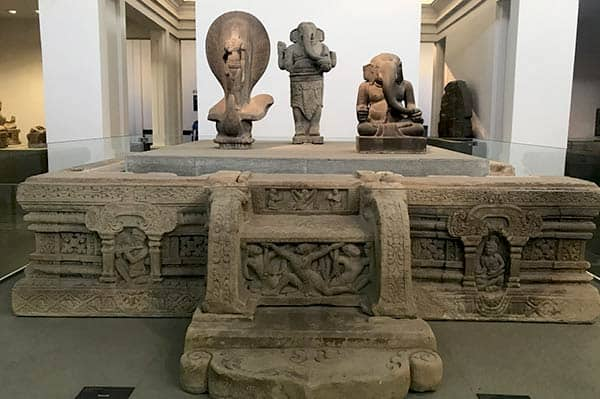DA NANG - CENTRAL VIETNAM
A BALNEARY STATION AT THE UNIQUE PAST
Da Nang marks the mid-point of your trip to Vietnam between the capital in the north, Hanoi, and Ho-Chi-Minh-Ville in the south. Moreover, this city in central Vietnam is the fourth largest in the country.
History of Da Nang
During Ancient Vietnam
Da Nang's origins go back to the ancient Kingdom of Champa, a Malay-Indonesian people who arrived in Vietnam from Java around 200 BC! The current name of the city is generally considered to be a Vietnamese adaptation of the word Champa da nak, which is translated as "the opening of a great river".
It was during the second half of the 10th century that the Dai Viet (former name of the Vietnamese) came into conflict with the Champa, a conflict that lasted until the end of the 11th century, when the Chams were forced to cede their three provinces... Shortly afterwards, Vietnamese peasants began to settle in the former unused Cham lands, resulting in the annexation of most of the Cham territories at the end of the 15th century.

Cham sculpture museum in Da Nang
First contact with Europeans
One of the first Europeans to visit Da Nang was the Portuguese explorer António de Faria, who landed in Da Nang in central Vietnam in 1535. Faria was one of the first Westerners to write about the region and, thanks to his influence, Portuguese ships began to call regularly at Hoi An, which was then a much larger port than Da Nang.
In the 17th and 18th centuries, French and Spanish traders and missionaries regularly landed in Hoi An. However, following the edict of Emperor Minh Mang in 1835, prohibiting European ships from landing or continuing trade except at the port of Hàn, Da Nang quickly overtook Hoi An, thus becoming the largest commercial port in Central Vietnam.
French Indochina
In 1847, French ships bombed Da Nang under the pretext of persecuting Catholic missionaries. In August 1858, still under the pretext of religious persecution, French troops, under the orders of Napoleon III, landed at Da Nang.
Through two decades of conflict, the French gradually strengthened their hold on Vietnam, leading to the creation of French Indochina in October 1887, Da Nang being renamed two years later in Tourane.
Republic of Vietnam
During the Vietnam War, the current Da Nang International Airport was a major air base used by the South Vietnamese and American air forces. Refugees in the city of Hue contributed to a population increase in the aftermath of the military events in Hue in 1968, which then exceeded one million inhabitants.
Da Nang today
Da Nang is now one of the five largest cities in Vietnam. Despite its colonial past, the city is experiencing an economic boom symbolized by its many recent skyscrapers. In addition, the Da Nang coast extends over 30 km and seaside activities such as fishing, water skiing and diving are more and more numerous and crowded every year.
What to do in Da Nang?
The beaches
Beaches are probably the main reason for Da Nang's popularity as a tourist destination, so here is a list of beaches that will be a good starting point for your visit to this coastal city in Central Vietnam.
Non Nuoc is considered one of the most beautiful beaches in the world. In addition to being equipped with many activities such as surfing or diving, it is very close to many points of interest such as the marble mountain
My Khe, popular by its history (American soldiers being sent there for rest), is today one of the most luxurious beaches in Vietnam and attracts both local and international visitors!
Nam O located 17km northwest of the city offers boat tours of small villages and will allow you to eat some local fish specialities in restaurants on stilts.
The Cham Museum
Many recovered statues, sculptures and reliefs are kept at the Cham Art Museum, near the Hàn River in the heart of Da Nang. Dating from the 4th to 14th centuries, the works describe daily activities as well as Hindu and Buddhist religious themes.
In addition, the Cham Sculpture Museum, with all its antique collections, has made it possible to introduce Cham culture to a very large number of people from all over the world.
Water sports
Da Nang being one of the most popular seaside resorts in the country, it is logical to find many sports and water activities there. You will be able to find there in particular:
Scuba diving, whether you are a beginner, amateur or professional, many centres will be at your disposal to carry out expeditions, especially in the Son Tra peninsula or on the banks of Cham Island.
Sea trekking, consisting of a walk on the bottom of the sea while experiencing underwater life.
Wakeboarding, this time you will be able to admire the land with a small surf (easy to handle) pulled by a fast boat.
Surfing, once again, whether you are a beginner or a professional, you can enjoy a surf lesson with a teacher, or just rent some to indulge your passion in autonomy.
Kayaking, which is quite popular with tourists who want to see the city from another angle when sailing on the Han River.
Da Nang is an interesting stopover on a trip to Central Vietnam for lovers of seaside resorts, water sports and history.



